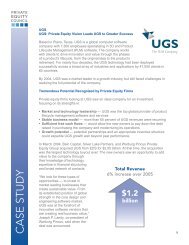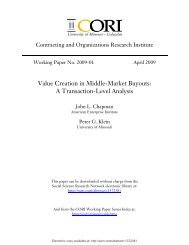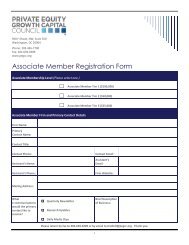PEC Letterhead Template
PEC Letterhead Template
PEC Letterhead Template
Create successful ePaper yourself
Turn your PDF publications into a flip-book with our unique Google optimized e-Paper software.
Kraft-Cadbury as a Frame of Reference for Private Equity Transactions<br />
Many reporters and market commentators subscribe to a certain narrative about the<br />
supposed excesses of the largest private equity acquisitions agreed to in the years<br />
immediately preceding the onset of the credit crunch. Yet, according to data from<br />
Standard & Poor’s, the large private equity transactions from that period were actually<br />
valued and financed more conservatively, on average, than Kraft’s acquisition of<br />
Cadbury.
Valuation. Kraft intends to pay 13-times Cadbury’s 2009 earnings before interest,<br />
taxes, depreciation and amortization (EBITDA). This is much more than private equity<br />
firms paid for large companies, on average, during 2002-2008. The chart below (from<br />
S&P Leveraged Commentary and Data), shows the average purchase price multiple for<br />
private equity acquisitions from 1987-2008. During the supposed “bubble” of 2006-<br />
2008, the average PE acquisition was valued at about 9.5-times EBITDA, or 27% less<br />
than Kraft’s bid for Cadbury (alternatively, Kraft paid a price that was 37% more than the<br />
average large private equity transaction of 2006-2008). The typical large private equity<br />
transaction during the valuation peak of 2007 was priced at a 25% discount to Kraft’s<br />
acquisition of Cadbury (Kraft paid a 33% premium relative to the 2007 large PE<br />
average).<br />
2
Financing. Based on current stock prices and exchange rates, cash comprises 60% of<br />
the bid, or $11.6 billion. According to its most recent financial report, Kraft had $2.996<br />
billion in cash on its balance sheet. The cash for the acquisition will come from the sale<br />
of existing businesses and $9 billion in acquisition financing from a syndicate of nine<br />
banks. The details of the financing will be provided in the Final Offer Documents, but<br />
the financing is expected to take the form of leveraged loans sold to institutional<br />
investors. The main proponent of the leveraged financing was Warren Buffet, who<br />
opposed the use of more equity to complete the deal.<br />
With $9 billion of acquisition financing and an existing debt load of $2.24 billion, the total<br />
debt of $11.24 billion is equal to 6.74-times Cadbury’s 2009 EBITDA of $1.67 billion.<br />
This leverage ratio is 24% higher than the average debt-to-cash flow ratio for large<br />
private equity acquisitions from 2005-2008. Even in 2007, the average large private<br />
equity transaction relied on 8% less debt than Kraft’s acquisition of Cadbury.<br />
3











